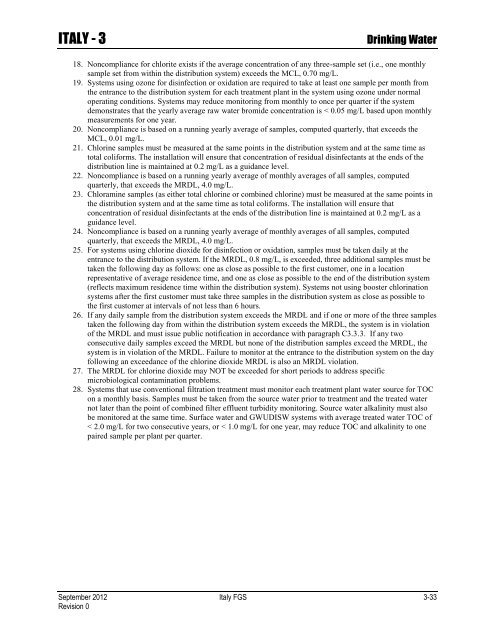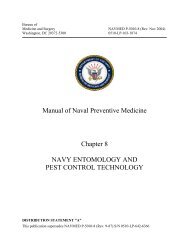ENVIRONMENTAL FINAL GOVERNING STANDARDS ITALY
ENVIRONMENTAL FINAL GOVERNING STANDARDS ITALY
ENVIRONMENTAL FINAL GOVERNING STANDARDS ITALY
You also want an ePaper? Increase the reach of your titles
YUMPU automatically turns print PDFs into web optimized ePapers that Google loves.
<strong>ITALY</strong> - 3 Drinking Water<br />
18. Noncompliance for chlorite exists if the average concentration of any three-sample set (i.e., one monthly<br />
sample set from within the distribution system) exceeds the MCL, 0.70 mg/L.<br />
19. Systems using ozone for disinfection or oxidation are required to take at least one sample per month from<br />
the entrance to the distribution system for each treatment plant in the system using ozone under normal<br />
operating conditions. Systems may reduce monitoring from monthly to once per quarter if the system<br />
demonstrates that the yearly average raw water bromide concentration is < 0.05 mg/L based upon monthly<br />
measurements for one year.<br />
20. Noncompliance is based on a running yearly average of samples, computed quarterly, that exceeds the<br />
MCL, 0.01 mg/L.<br />
21. Chlorine samples must be measured at the same points in the distribution system and at the same time as<br />
total coliforms. The installation will ensure that concentration of residual disinfectants at the ends of the<br />
distribution line is maintained at 0.2 mg/L as a guidance level.<br />
22. Noncompliance is based on a running yearly average of monthly averages of all samples, computed<br />
quarterly, that exceeds the MRDL, 4.0 mg/L.<br />
23. Chloramine samples (as either total chlorine or combined chlorine) must be measured at the same points in<br />
the distribution system and at the same time as total coliforms. The installation will ensure that<br />
concentration of residual disinfectants at the ends of the distribution line is maintained at 0.2 mg/L as a<br />
guidance level.<br />
24. Noncompliance is based on a running yearly average of monthly averages of all samples, computed<br />
quarterly, that exceeds the MRDL, 4.0 mg/L.<br />
25. For systems using chlorine dioxide for disinfection or oxidation, samples must be taken daily at the<br />
entrance to the distribution system. If the MRDL, 0.8 mg/L, is exceeded, three additional samples must be<br />
taken the following day as follows: one as close as possible to the first customer, one in a location<br />
representative of average residence time, and one as close as possible to the end of the distribution system<br />
(reflects maximum residence time within the distribution system). Systems not using booster chlorination<br />
systems after the first customer must take three samples in the distribution system as close as possible to<br />
the first customer at intervals of not less than 6 hours.<br />
26. If any daily sample from the distribution system exceeds the MRDL and if one or more of the three samples<br />
taken the following day from within the distribution system exceeds the MRDL, the system is in violation<br />
of the MRDL and must issue public notification in accordance with paragraph C3.3.3. If any two<br />
consecutive daily samples exceed the MRDL but none of the distribution samples exceed the MRDL, the<br />
system is in violation of the MRDL. Failure to monitor at the entrance to the distribution system on the day<br />
following an exceedance of the chlorine dioxide MRDL is also an MRDL violation.<br />
27. The MRDL for chlorine dioxide may NOT be exceeded for short periods to address specific<br />
microbiological contamination problems.<br />
28. Systems that use conventional filtration treatment must monitor each treatment plant water source for TOC<br />
on a monthly basis. Samples must be taken from the source water prior to treatment and the treated water<br />
not later than the point of combined filter effluent turbidity monitoring. Source water alkalinity must also<br />
be monitored at the same time. Surface water and GWUDISW systems with average treated water TOC of<br />
< 2.0 mg/L for two consecutive years, or < 1.0 mg/L for one year, may reduce TOC and alkalinity to one<br />
paired sample per plant per quarter.<br />
September 2012 Italy FGS 3-33<br />
Revision 0
















